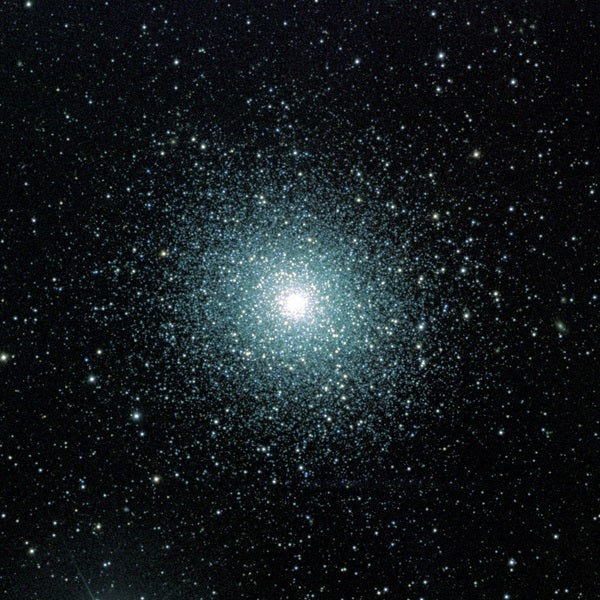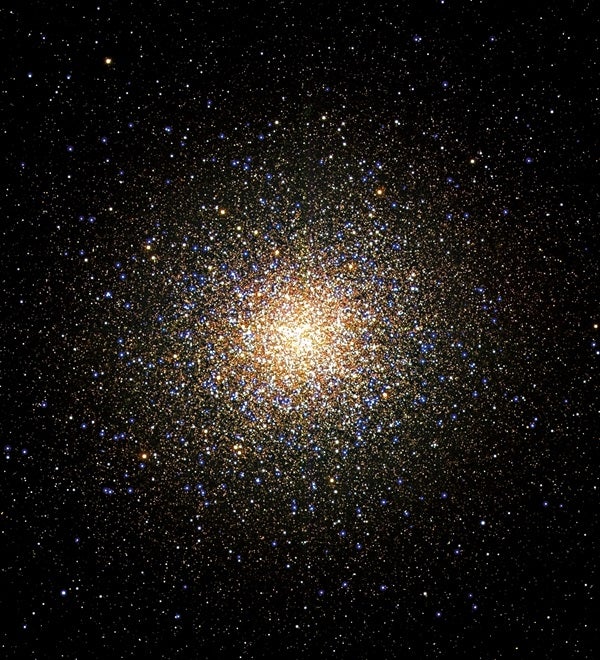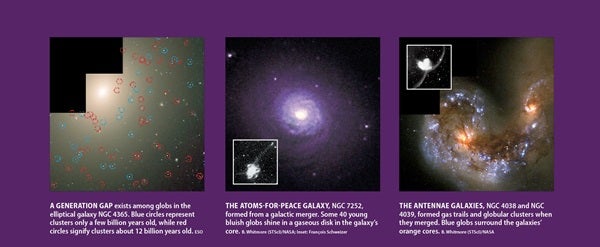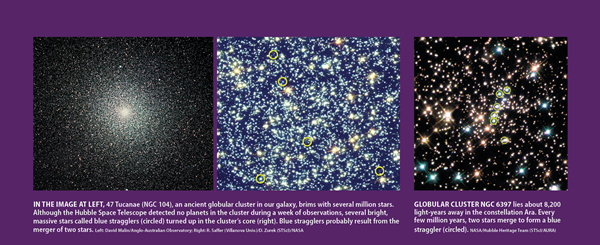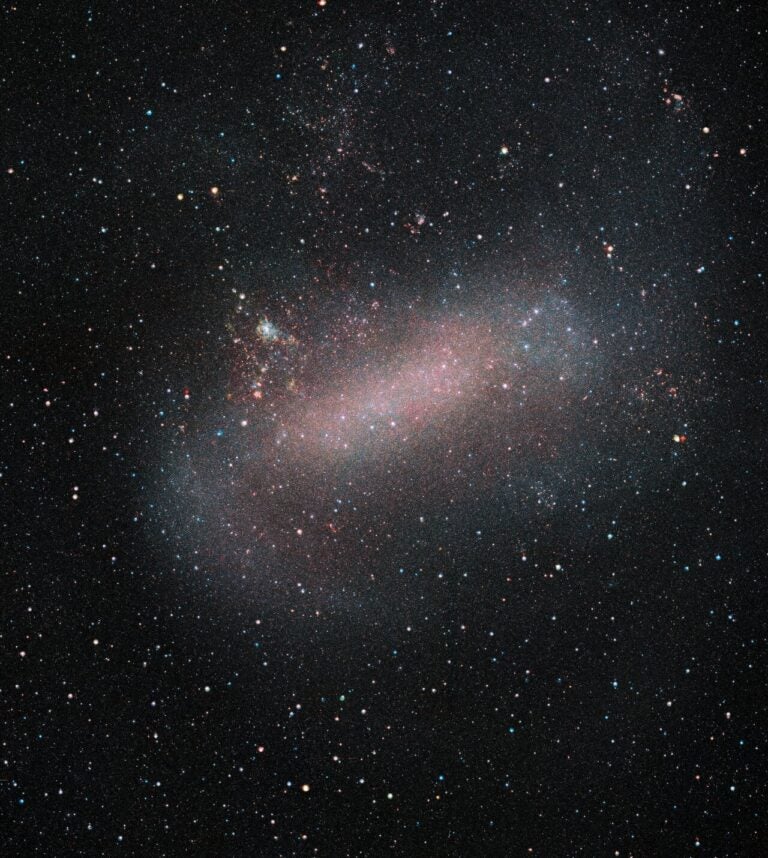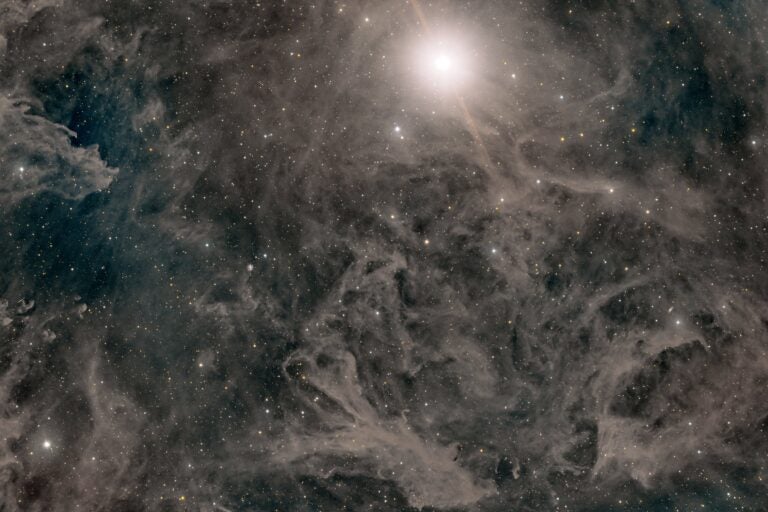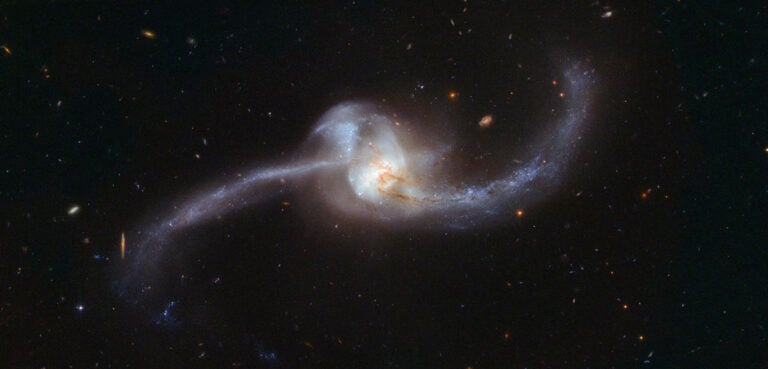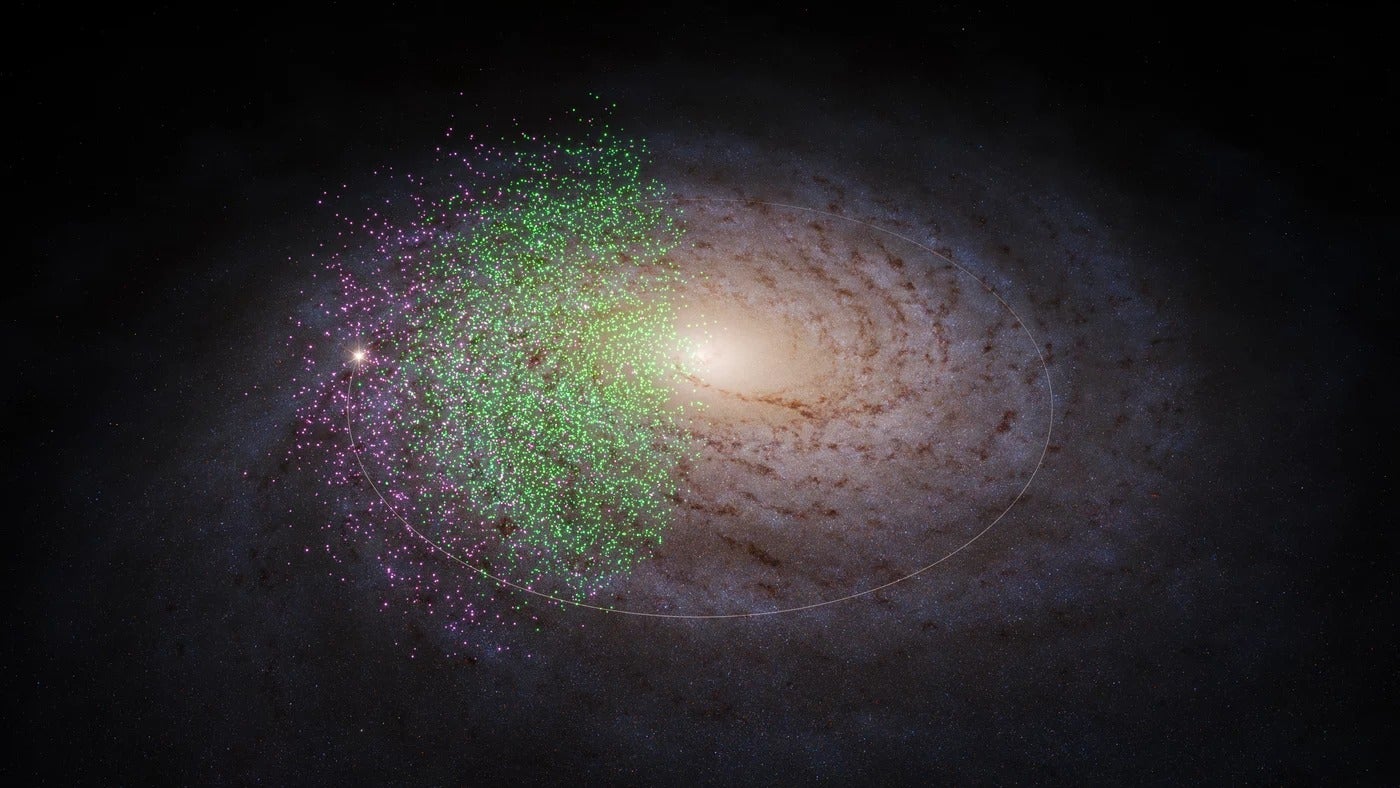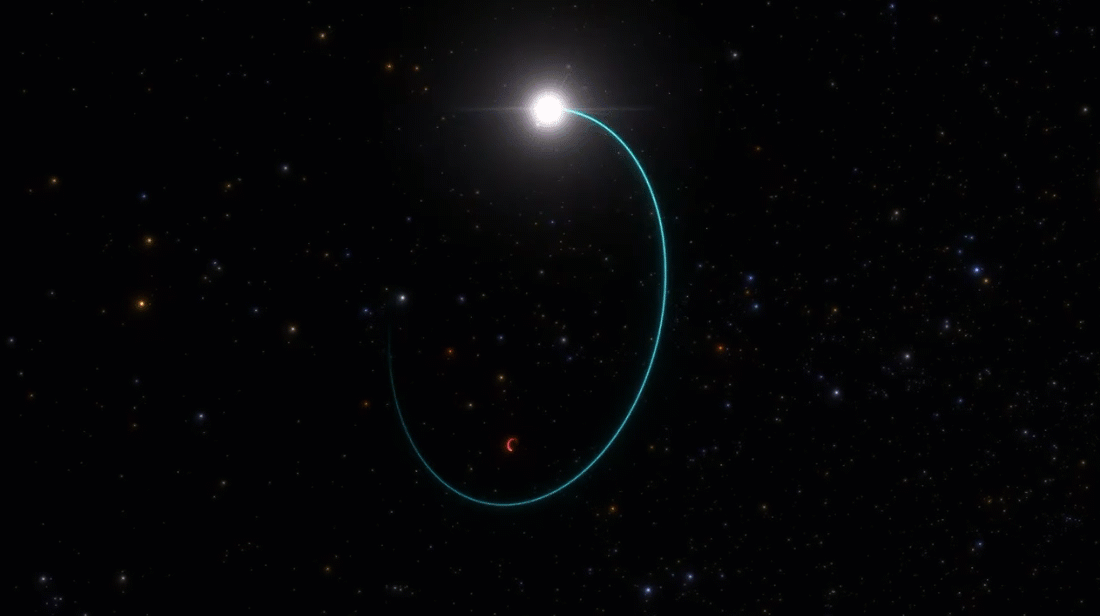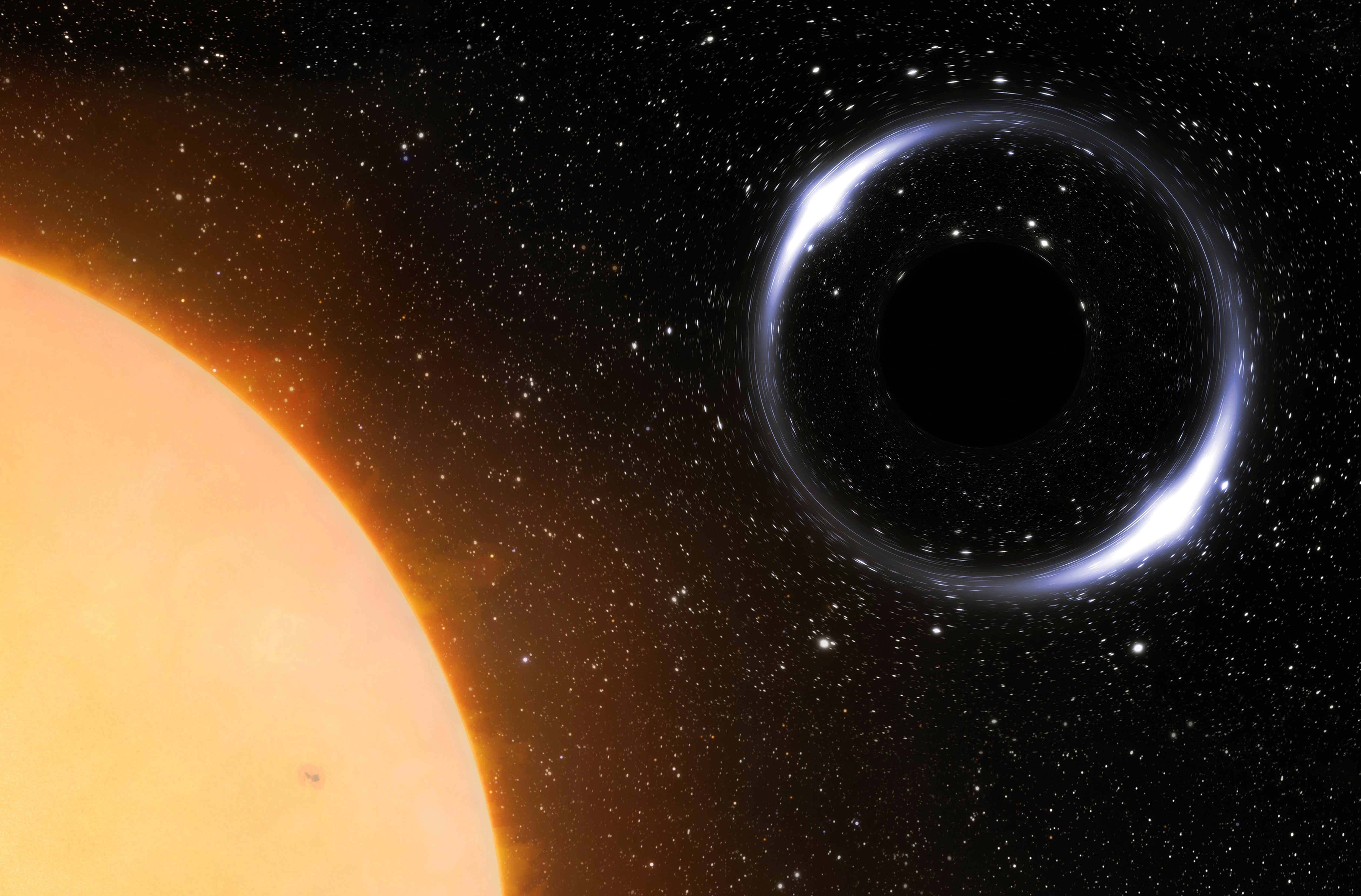The globular clusters surrounding the Milky Way, some 150 in all, gleam like cosmic sparklers frozen in time. In each, brilliant specks of light hover around a dense and blazing core. Within a sphere only 100 light-years wide, anywhere from 1,000 to 10 million stars exist, bound by mutual gravitational attraction.
One of the finest examples lies in the constellation Serpens. The German astronomer Gottfried Kirch and his wife Maria Margarethe first noticed this object on the night of May 5, 1702. In her diary, Margarethe described the compact patch as a neblichte Sternchen (nebulous star). The French comet-hunter Charles Messier rediscovered it in 1764 and also was unable to distinguish its clusterlike quality, calling it a “beautiful nebula.” It was fifth on the list in Messier’s famous catalog of celestial objects that were not comets, so it became M5.
Not until 1791 did William Herschel, the most accomplished observer of his time, at last resolve M5 into a compact ball of stars. With his 48-inch telescope that had a focal length of 40 feet, he counted some 200 stars within it. Herschel already had a theory to explain (and name) this amazing assembly. In a famous 1785 paper in the Philosophical Transactions of the Royal Society of London entitled “On the Construction of the Heavens,” he wrote about the formation of nebulae. He imagined a particularly large star attracting others to it “by which means they will be, in time, as it were, condensed about a center; or, in other words, form themselves into a cluster of stars of almost a globular figure.”
Today, the Hubble Space Telescope can probe into the very heart of a Milky Way globular cluster. Often described as a mound of diamonds on black velvet, a globular cluster seen with Hubble’s keen eye takes on a far more colorful appearance, with red giants dotting the cluster like large rubies and blue stragglers resembling glittering aquamarines.
Astronomers have renewed appreciation for more than just the clusters’ colors. “At the time I was a graduate student in 1970,” says globular cluster expert William Harris of McMaster University, “globular clusters were thought to be a routine area of study. The clusters were considered among the oldest objects in the universe — all the same from one to the other. Some were bigger, some smaller. It was not a terribly active field.”
But all that’s changed over the last 25 years. Electronic digital detectors on ground-based telescopes, coupled with optical, ultraviolet, and infrared imaging on Hubble, have allowed astronomers to study the magnitudes, colors, and distribution of globular clusters beyond our galaxy, and even beyond the Coma Cluster of galaxies. “We were too caught up with what happened here in the Milky Way,” explains Harris.
It seems globular clusters patronize all types of galaxies, although the clusters themselves make up just a tiny fraction of most galaxies’ stellar mass (usually no more than one percent). A dwarf galaxy may claim just one globular cluster, and giant ellipticals, such as M87 in the Virgo Cluster, may host more than 10,000 clusters that huddle around the galaxy like a swarm of bees. “We’re finally seeing other neighborhoods and are forced to conclude that there’s a much wider range of globular clusters than we realized,” Harris says. “We now have a much larger playground in which to play.”
Astronomer James Hesser of the Herzberg Astronomy and Astrophysics Research Centre agrees. “The new technologies were magic,” he says. “Instead of using insensitive, nonlinear photographic plates to do photometry and then carrying out laborious photoelectric calibrations via single stars, we suddenly could do hundreds of stars quickly and accurately.” The resulting surge of data changed the understanding scientists had of these “globs” (as amateur astronomers like to call them) that had stood for decades.
Early studies
All globular cluster research is inevitably rooted in the observations of astronomer Harlow Shapley, who “cast a long shadow on the field,” notes Harris. “He was the first to talk about globular clusters as a system, a population.” In the 1910s, while at Mount Wilson Observatory in California, Shapley published a series of articles on the Milky Way’s globular clusters.
In the 12th paper, he announced what became his most famous discovery: From the distribution of globulars around our galaxy, he concluded that the Sun is situated not in the galaxy’s center but off to one side of the flat disk of stars. Later, Edwin Hubble detected globular clusters in the nearby Andromeda Galaxy, determining that globulars are members of other galaxies as well.
Globular clusters were typically defined as the oldest objects in the universe, all predating their host galaxies and all alike. The first hints that not all globulars are created equal arose in the 1940s and ’50s, when a few dedicated cluster observers, particularly N.U. Mayall of California’s Lick Observatory, William Wilson Morgan of Wisconsin’s Yerkes Observatory, and Tom Kinman of the National Optical Astronomy Observatory in Tucson, Arizona, found evidence that clusters vary both in content and speed. In 1994, when the Sagittarius Dwarf Spheroidal Galaxy was discovered as a companion to the Milky Way, it turned out the dwarf’s nucleus was globular cluster M54.
And globular clusters form even today — in the aftermath of recent galaxy interactions, mergers, and starburst events. This finding would have been unbelievable half a century ago, when the first age estimates of globular clusters were made by comparing observations of cluster stars with theories of stellar evolution. “In the early days of globular cluster studies,” says Catherine Pilachowski of Indiana University, “astronomers attempted to find one answer to how and when they were made. But now we know there are probably many paths.”
For richer or poorer
Today astronomers view globular clusters as vital relics of the galaxy formation process itself, offering clues to how a particular galaxy arrived at its size and shape.
Far from being uniform, globular clusters differ by age and content. Some are “metal poor,” meaning they do not have great quantities of elements heavier than helium, whose most abundant form contains two protons and two neutrons in its nucleus. Because most of the heavier elements were forged by nuclear fusion in stars and distributed by supernovae, metal-poor clusters indicate an early formation from primordial material.
Other globular clusters have been found to be “metal rich” (containing one-sixth or more of the Sun’s abundance of heavier elements). Astronomers believe metal-rich globs formed after one or more rounds of star formation and stellar explosions scattered heavier elements, like ashes, into space. “These [different types] must represent fairly distinct epochs of cluster formation,” wrote Harris in a 1999 review of the field.
In the Milky Way, the classic, metal-poor clusters reside predominantly in the outer halo of our galaxy and move rather slowly. Metal-rich clusters tend to dwell around the central galactic bulge, to orbit more rapidly, and to be 1 billion to 2 billion years younger than their metal-poor cousins.
Different types of globular clusters inhabiting different zones within our galaxy might be evidence that the Milky Way underwent separate phases of assembly. The exact details are under debate, but “there’s a growing sense,” says Pilachowski, “that the metal-poor globular clusters were acquired through the merger of smaller systems that had already created their globulars.”
This meshes nicely with recent observations showing young galaxies being assembled from smaller fragments. The metal-rich clusters apparently formed later, during the collapse of the larger Milky Way cloud.
That the Milky Way could have developed in phases is still speculative, though, Harris says. “Clusters represent only one percent of the stellar mass of a galactic halo,” he points out. “We shouldn’t assume that they tell us exactly how galaxy formation took place. They’re special objects and may be telling us only part of the story.”
In galaxies outside our own, metal-poor globular clusters appear to have similar makeups, suggesting they formed under identical circumstances before their host galaxies were created. Metal-rich clusters, on the other hand, mirror the metallicities of their hosts, varying from galaxy to galaxy. Moreover, the number of metal-rich clusters in any one galaxy appears to be directly linked to the galaxy’s luminosity: The more luminous a spiral bulge or elliptical, the greater number of metal-rich globular clusters surrounding it. What this says about a galaxy’s formation and evolution, though, is still being debated. François Schweizer of the Carnegie Observatories believes many of the metal-rich clusters surrounding ellipticals could be fairly new, an idea that provoked gasps among astronomers when he first made the suggestion more than 30 years ago.
Mergers make gobs of globs
In the 1970s, brothers Alar and Juri Toomre, now a professor of applied mathematics at the Massachusetts Institute of Technology and an astrophysicist at the University of Colorado at Boulder, respectively, carried out computer simulations suggesting elliptical galaxies arose from the merger of disk galaxies. Such an idea was a highly radical notion at the time. Schweizer, however, was greatly influenced by the Toomres’ work and soon established a career hunting for examples of merged galaxies. His first successful find was spiral galaxy NGC 7252, whose curved filaments jut out of a fuzzy center. Known as the Atoms-for-Peace galaxy for its vague resemblance to the old-fashioned symbol for an atom, NGC 7252 is generally accepted to have formed about a billion years ago from the turbulent union of two galaxies.
But in 1986, when Schweizer attended an astronomy conference in Santa Cruz, California, generating ellipticals from mergers was still considered heresy. Conferees pointed to the “old” globular clusters surrounding elliptical galaxies as evidence of their great age. Schweizer readily responded that some of those globular clusters likely were new — freshly minted during the merger process. “People at this meeting thought I was nuts,” recalls Schweizer. “I had never worked on globular clusters, so I knew the suggestion might ruin my career.” At the time, globular clusters were deemed ancient by definition.
But Schweizer had a hunch: He had seen some weird little dots around NGC 7252 and another merger suspect, NGC 1316 (the noted radio galaxy Fornax A). He thought the dots looked suspiciously like new globular clusters. “Nature knows how to make globular clusters long after the Big Bang — mergers are the process,” he explains.
Schweizer was vindicated later by the Hubble Space Telescope as well as larger telescopes on the ground. Looking at the Antennae (NGC 4038 and NGC 4039), a stunning display of two merging galaxies, Schweizer and several colleagues detected thousands of star clusters that had been created within the great clash. When giant clouds of molecular hydrogen embedded in the merging galaxies suddenly experienced rising pressures, they underwent a violent round of star formation.
Within several hundred million years, most of those clusters will be destroyed, their stars dispersed into the field. The most massive stars will die quickly and explode, tearing the cloud apart with supernova blasts. But if the galactic cloud held enough mass in a small volume, some globular clusters probably would survive.
Schweizer and University of Michigan astronomer Patrick Seitzer closely examined older mergers that had time to settle down. In NGC 7252, for example, they found eight young globular clusters that were still very blue, indicating an age of only half a billion years or so (practically newborn in cosmic terms). Many more probably remained hidden by dense clouds of interstellar gas. Schweizer estimates that some 500 globular clusters reside around NGC 7252 — half of them old, half of them new.
This leads to the $64,000 question among globular-cluster observers: Can late mergers explain the thousands of globular clusters found around giant elliptical galaxies? It’s still too soon to tell.
“In order to peg the exact ages of globulars in the distant universe, we need larger telescopes to carry out the necessary spectroscopy,” notes Hesser. Astronomers no longer doubt that galaxy mergers can create new populations of globular clusters. “But I sense they’re a minor component” of the overall pool, he says.
Harris concurs, pointing out that it’s difficult to build a tightly bound system like a globular cluster. “Two galaxies merging might make around 300 clusters, but to make thousands would require 10 trillion Suns’ worth of mass — the raw material out of which the clusters and all other field stars are made,” he says. “The only epoch during which such huge amounts of gas were routinely available within galaxies was the protogalactic era itself.” Both Hesser and Harris agree that mergers likely triggered the creation of globular clusters but believe merging protogalactic clouds — as opposed to fully formed galaxies — during the first wave of galaxy formation created the bulk of clusters. From this viewpoint, the Antennae and NGC 7252 are mere shadows of what was happening billions of years ago.
Ancient globulars date the universe
The small age difference of the Milky Way’s globular clusters supports the idea that the majority of clusters were constructed soon after the Big Bang. The most pristine clusters, the ones that have less than one percent of the abundance of metals found in the Sun, are around 12 billion to 13 billion years old. This makes them among the oldest objects in the cosmos and, in essence, yields a good estimate of the universe’s age. The more metal-rich clusters in the Milky Way are only a couple of billion years younger. This suggests there was an epoch of massive star cluster formation that began about a billion years after the Big Bang and lasted for a few billion years. It also bolsters views of the early universe, such as in the Hubble Deep Fields, which show galaxies that appear bluer and more agitated in that distant era.
Hesser is pleased that globular cluster ages match estimates of the universe’s age calculated from the latest measurements of the cosmic microwave background, the relic radiation from the Big Bang. “Two completely different tests arrive at the same answer!” he says. That wasn’t always the case. For many years, calculations based on standard cosmological models indicated the universe was 10 billion years old, younger than the globular clusters. It was a disturbing paradox: How could stars be older than the universe? It was an irreconcilable age difference, and astronomers knew they needed to amend their understanding of the universe.
Help arrived in 1999 with the discovery that the universe is accelerating, its rate of expansion growing faster and faster due to the presence of “dark energy” that appears to pervade space-time. With this added energy gradually boosting cosmic expansion over the eons, the universe was found to be older, eliminating the paradox.
At the Astronomical Society of the Pacific conference on globular clusters in 1994, Hesser confessed to his colleagues: “I sometimes get the feeling — perhaps some of you do, too? — that I’m not doing real astronomy (for example, the quest for quasars, primeval galaxies, etc.).” He went on to say: “Tonight, however, armed only with binoculars and a chart from any good sky atlas, you can view a majestic object whose chemistry suggests it formed [soon after the Big Bang]: M15 … and it’s only a few kiloparsecs distant!”
Astronomy’s own Cirque du Soleil
Globular clusters’ use as cosmological markers sometimes overshadows their uniqueness as celestial objects. With stars packed in like subway commuters at rush hour, a globular cluster offers a far more exotic environment than the staid suburbs of the Milky Way’s disk. Here in the disk, the Sun’s closest stellar neighbor, Alpha Centauri, is some 4 light-years away. But if the Sun were located in the center of a globular cluster, it would have a bustling community of 1,000 or more stars closer than Alpha Centauri, lighting up Earth’s sky during both day and night. Near-misses between stars would be commonplace.
What holds these stars together so compactly? Powerful computer simulations have begun to answer this long-held mystery.
A cluster in its youth does not just sit; it evolves as kinetic energy is exchanged continually between the stars. Lower-mass stars rev up their velocity and eventually “evaporate” out of the system, while higher-mass stars lose energy and sink toward the center. Over time, the outskirts of a cluster spread out, and the core gets denser, creating the hallmark spherical shape of a globular.
Why doesn’t the entire globular cluster completely collapse into a black hole as it shrinks? Simulations show that before this happens, some stars begin to interact and form binary systems, which puts a stop to the crunch. Like partners in a fast-paced square dance, these stars swiftly swing around one another, sometimes pairing up for good or, on rare occasions, merging.
That explains the mystery of “blue stragglers.” Long seen in clusters, these massive stars are bluer and brighter than the average main sequence star; astronomers now realize they result from mergers of two smaller stars. “They stand out very easily,” notes Harris. “They’re rare but easy to spot.”
And blue stragglers aren’t even the most exotic characters in these jam-packed systems. X-ray telescopes reveal the truly bizarre: cataclysmic variable stars, millisecond pulsars, and neutron-star binaries. The oldest known planet recently turned up around a binary consisting of a pulsar and a white dwarf star in the relatively nearby globular cluster M4 — the first time a planet has been found in a glob (see above). Says Harris, “The field has opened up in ways that no one had imagined.”

